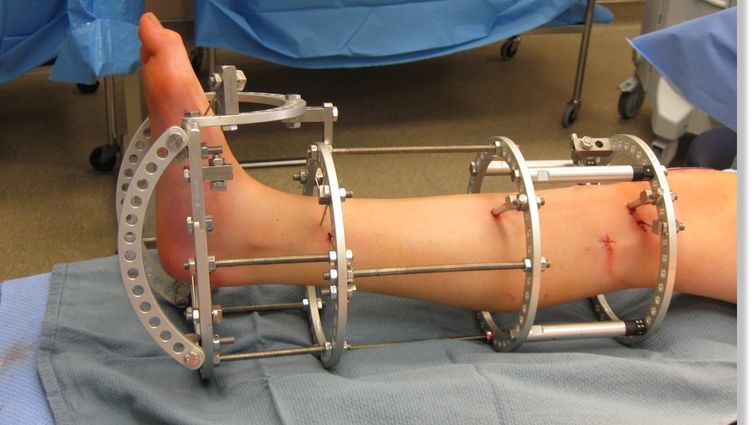

Dr. Nelson emphasizes the benefits of the procedure, as well as the potential dangers when it is not used correctly.
Limb lengthening, a medical procedure that increases bone or limb length, has gained significant popularity in recent years due to viral stories of patients undergoing surgery to increase their height. However, the surgery was intended as a medical necessity for children born with congenital conditions or to repair traumatic injuries rather than a cosmetic enhancement.
The procedure was developed in the 1950s by a surgeon who discovered the body could generate new bone. This discovery has been used to treat children and adults suffering from various conditions, including:

-
Congenital conditions (often referred to as birth defects): Limb length discrepancy, fibular hemimelia, or congenital femoral deficiency
-
Post-traumatic discrepancies: Traumatic injuries that involve bone loss can lead to one limb being shorter than the other
-
Growth plate damage: Trauma to a growth plate during childhood can disrupt normal bone development
-
Dwarfism: Individuals with conditions like achondroplasia (a form of dwarfism) may undergo limb lengthening to improve mobility and overall function
These conditions can cause significant disability, and limb lengthening offers a way to restore balance and function.
Scott Nelson, MD, an orthopaedic surgeon and limb lengthening specialist at Loma Linda University Health, has been instrumental in performing life-changing limb lengthening procedures both locally and globally, helping patients achieve greater mobility and a chance at a more functional life.
"Our main focus is performing limb lengthening procedures, primarily for children born with congenital limb discrepancies — where one limb is shorter than the other — as well as for individuals of all ages who have experienced trauma resulting in significant limb shortening and disability,” Nelson explains. “The process, technology, and medical advancements in this field have been truly life-changing."
What is a limb lengthening procedure?
Limb lengthening can be performed through several techniques using either an external fixator or an intramedullary device.
External fixator
One of the more traditional methods for limb lengthening uses an external fixator. The external fixator is then attached to the bone with pins and remains on the outside of the leg. Then a small incision, less than a centimeter in size, where the bone is carefully fractured.
For a predetermined period of time, patients make small adjustments on the fixator daily, gradually stretching the bone at a rate of about one millimeter per day. Computer-based software is often used to help calculate the fixator’s movements. A detailed, color-coded printout provides patients with clear instructions on how much to turn each dial daily.
“With good, stable fixation and very slow stretching, the gap between the two bone ends begins to fill in with new bone,” Nelson says.

While the fixator may appear painful, most patients adapt to wearing it and do not experience constant discomfort. However, to minimize stiffness of the surrounding areas –– nerves, blood vessels, tendons, ligaments, joints, and muscles –– physical therapy (PT) is crucial.
Nelson explains that while PT can be uncomfortable due to the extensive stretching and mobility exercises required, a skilled therapist familiar with limb lengthening procedures understands how to keep patients motivated. This is especially important for children, who can undergo the procedure as early as three years old.
Intramedullary device
In the mid-2010s, a groundbreaking internally implanted device called the intramedullary device began to revolutionize the limb lengthening process. The intramedullary rod is an internal lengthening device that is inserted into the bone, which is similar to rods used to stabilize broken bones in traumatic injuries.
The device contains a built-in magnet and a rotating gear that patients can adjust using an external electronic device — about the size of a load of bread — that activates the magnet and gradually extends the rod. This allows the bone to lengthen at a controlled rate, up to eight centimeters.
This method is particularly beneficial for femur lengthening, as it reduces the discomfort associated with external fixators pressing against surrounding muscles. It has expanded the possibilities for both medical and cosmetic limb lengthening, making the procedure more accessible and less invasive than ever before.
The three-part process of limb lengthening
The limb lengthening process is divided into three distinct phases: Latency, lengthening, and consolidation phases.
Phase 1: Latency
The latency phase begins immediately after surgery and lasts about a week. During this time, no movement occurs as the healing process begins.

Phase 2: Lengthening
The lengthening phase can last anywhere from a few days to three months, depending on the amount of lengthening required. Patients can achieve an increase of up to 2 – 3 inches in a single procedure, which proceeds at about 1mm per day. If additional lengthening is needed, the patient will need to undergo another operation at a later time. Throughout this phase, patients undergo intensive PT to maintain mobility and flexibility. Complications can often occur, but if dealt with appropriately, can usually be resolved without affecting the final outcome.
Phase 3: Consolidation
The consolidation phase allows the newly formed bone to harden and become strong enough to support weight. Nelson says that this phase lasts twice as long as the lengthening phase. For instance, if a patient undergoes three months of lengthening, they may need to keep an external fixator in place for an additional six months to ensure proper bone healing.
Life during lengthening
Limb lengthening is very challenging and requires effort on the part of the surgeon, the patient, physical therapists, and other support staff during the entire process.
“After surgery, we get patients up and walking right away, which helps prevent blood clots and keeps them mobile,” Nelson says. “The external fixator is strong so patients can be quite functional. They can take showers, swim, and generally enjoy life during the process.”
Limb lengthening as a cosmetic procedure
Those undergoing limb lengthening for a medical condition can expect insurance to help cover the extensive costs of the procedure. However, those without a medical condition and purely looking to enhance their height can expect to pay upwards of $100,000 out of pocket.
This cosmetic stature lengthening is becoming more popular but also poses ethical concerns due to the serious risks the surgery poses.
“The internal devices are not designed to bear weight during the lengthening phase,” Nelson warns. “While patients can perform basic transfers, such as standing up or moving from one chair to another, walking is not easy when both legs are undergoing treatment. Patients can stand but are not allowed to walk for approximately two to three months during the treatment process.”
Additionally, and far more concerning, are patients seeking cheaper procedures in countries where medical standards vary. Unfortunately, Nelson confirms that many patients bargain-hunting for their procedure end up with severe complications and even permanent mobility issues, especially when pushing beyond the standard 2 – 3 inches of limb lengthening.
Reports of individuals requiring multiple surgeries, using walkers, or even ending up in wheelchairs after botched procedures highlight the dangers of overambition. These cases emphasize the importance of proper medical oversight, ethical decision-making, and setting realistic goals for limb lengthening.
“At Loma Linda, the focus is on providing the best possible outcomes through ethical, high-quality procedures,” Nelson ensures. “As an academic center, we prioritize patient safety and the training of future surgeons to uphold these standards for both medical and cosmetic limb lengthening treatment.”
For more information, visit our Limb Lengthening Center to make an appointment.



